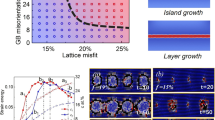Abstract
IT appears from various experiments that the ease with which a crystal can grow in a deformed matrix depends very much on the mutual orientation of growing and disappearing lattice domain. This is already obvious from the fact that, in a recrystallizing coarse-grained material, the new crystals show corrugated boundaries, demonstrating visibly that some of the original grains are consumed at a faster rate than others1. Recent experiments give a far more striking proof of this phenomenon.
Similar content being viewed by others
References
Burgers, W. G., Proc. Roy. Acad. Sci. Amsterdam, 50, 595 (1947).
Carpenter, H. C. H., and Elam, C. F., Proc. Roy. Soc., A, 100, 329 (1922).
Seumel, G., Z. Krist., 93, 249 (1936).
Lacombe, P., and Beaujard, L., J. Inst. Metals, 74, 1 (1947).
Burgers, W. G., Nature, 157, 76 (1946); 160, 398 (1947).
Burgers, W. G., and May, W., Rec. trav. chim. Pays-Bas, 64, 5 (1945).
Author information
Authors and Affiliations
Rights and permissions
About this article
Cite this article
MAY, W., TIEDEMA, T. & BURGERS, W. Inclusions in Aluminium Crystals. Nature 162, 740–741 (1948). https://doi.org/10.1038/162740b0
Issue Date:
DOI: https://doi.org/10.1038/162740b0
- Springer Nature Limited





